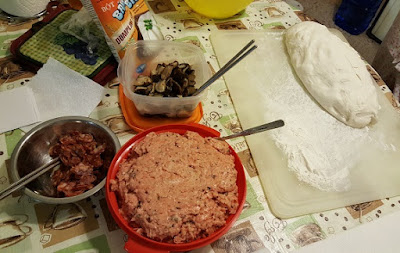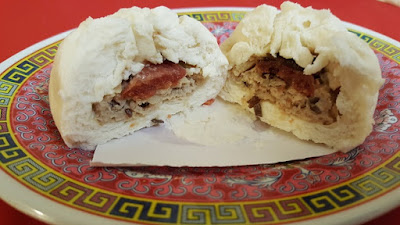The Task: Make something that is considered party food where you are from, and post a picture of it on Booklikes.
This little "delicacy" is called 大包 (dai bao) in Cantonese, and bánh bao in Vietnamese. I include the Vietnamese name because it's more commonly known that way where I live, where the Vietnamese population is more numerous than the Chinese-Cantonese population. It is basically a steamed pork bun, and literally translated (Cantonese) as "big bun." I don't know the Vietnamese translation, but according to Wiki, bánh bao literally means "wrapping cake."
For many others, you may be more familiar with these little pork buns as called nikuman (肉饅) or nikumanjuu (肉饅頭), in Japanese, which sort of translates to 'meat-filled steamed bun.'
It's not really a traditional holiday party food, as the Christmas holiday was never truly an Asian tradition. Nor is it specifically a traditional celebration type of food either, as there are other, more complex dishes, desserts, candies, and food items more befitting any other traditional Asian holiday celebration. But growing up, my mother and grandmother would make these during special occasions, specifically birthdays and the Lunar New Year. Of course, it wasn't until I was older that I learned that dai bao could be made any time without a special occasion prompt. In fact, you can buy them in most Asian supermarkets nowadays.
The reason my mother and grandmother reserved them for special occasions was mainly because of how tedious they are to make. It's really the dough that's the most time-consuming, as it involves mixing, rising, kneading, flattening, and then stuffing.
Dai bao or anything made in a similar fashion was always considered a staple food in certain parts of China, though not really the most luxurious delicacy. Specifically the bun without any filling whatsoever, known as 饅頭 (maan tau), was considered a street food for the common layperson, since meat was kind of a luxury. It kept you fed, but was made with some of the simplest ingredients of flour, yeast, salt, sugar, oil, and water--nowadays we can buy packages of self-rising flour, pre-mixed with everything necessary to make the bun with. I know a few many Vietnamese friends who prefer to put together their own mix from scratch.
Then you just choose your own filling and wrap it all up and steam until it all looks like a cloud of fluffiness (usually about 15 to 20 minutes). We like to add about a teaspoon of white vinegar to the water used to steam the buns, as it keeps the bao a nice white color--otherwise it turns yellow and looks kind of dirty and less presentable.
The dai bao we prepare in our household usually depends on what my mom has on hand for ingredients, but for the most part, we will use ground pork, chopped onions, chopped water chestnut, chopped black fungus (or wood ear fungus), slices of Chinese sausage, and shiitake mushrooms sliced in halves. Sometimes quartered hard-boiled eggs are involved. All the chopped ingredients are mixed into the pork filling, seasoning as is appropriate. The dough, after mixing and kneading and letting it rise, is then divided into pieces roughly the size of a tennis ball, maybe a little smaller, then flattened and rolled out to about palm-size.
The pork filling is added--and here is where I always mess up because I'm a terrible judge of how much pork filling to put in the bun. It's a guessing game dependent on how big my flattened piece of dough is, since we don't really measure anything. Too little pork filling and you've got a giant bun with no meat; too little, and you've got meat bursting out of the seams.
On top of the pork filling will go the Chinese sausage, which we try to squish into the pork, then the shiitake mushroom slice, then maybe the egg on top. Then we wrap the bun up, accordion-style all the way around, trapping all the filling on the inside, and creating a fancy looking folded fan patter on top, if done properly.
Mom says to just squish the remainder of the dough together to close up the opening; it will stick and keep everything inside. I like to give it a little twist, but that ends up creating a nipple-looking thing on the top of my steamed buns... (somehow that sentence just sounds all wrong).
Mom just pinches her bao opening together, somehow creating a more flawless pattern that I can't seem to get right.
Obviously, ours look a little rusty. But whatevs, it's the taste of the bun that's important, and after steaming for about 15 minutes, it comes out smelling yummy, and all the pork juices have soaked into the inside part of the steamed bun wrapping (which was always my favorite part of the bun).
This same dough may also be used for a number of different kinds of steamed bun snacks. Some include sweet fillings of red lotus paste or sweet mung bean. Some have what is called Kaya in them, which is a sweet jam-like paste made from coconut, eggs, and sugar; it has a very thick, creamy consistency, and is extremely sweet, but aromatic because of the coconut flavor. There are also vegetarian buns, or even smaller varieties that look more like dumplings.
In fact, though I couldn't take any pictures because my mom already finished them by the time I woke up, there is a Chinese barbecue roast pork (叉燒/char siu) my mother makes that is amazing! After the roast pork is finished, it may also be diced into small cubes, mixed with a sauce my mom prepares from the juices that dripped out of the roast pork during its roasting (of which she always takes pains to collect and reuse), a little bit of green onion and minced garlic, and then used as the filling. This is known as the 叉燒包/char siu bao, Steamed Barbecue Roast Pork Bun.
But to be honest, I like to eat the char siu by itself, because YUM!
Whatever it is that gets put into these bao, though, I've always loved, mainly because they make for an easy, convenient snack when they're handy. Even the steamed buns with no filling are good; Mom always says to add a little extra sweet to these during the dough mixing process. Personal opinion: they taste a lot better than a cold sandwich or a hamburger. And if wrapped with care, they look really pretty when set up to serve during ye 'olden celebratory feasts... or even more modern dinner parties!
They're just a pain in the butt to make, if only because it's pretty time consuming.

 Log in with Facebook
Log in with Facebook 

















